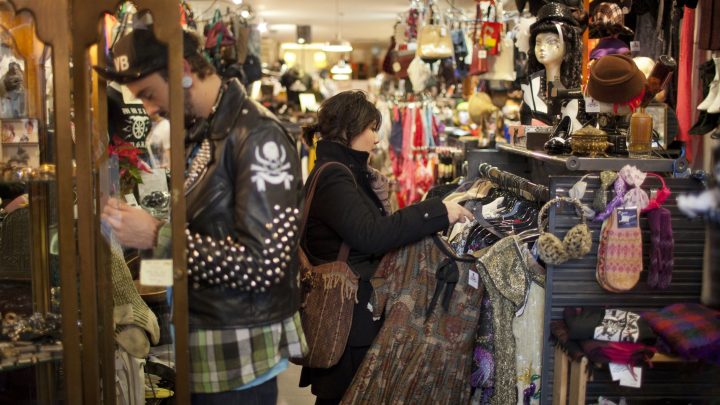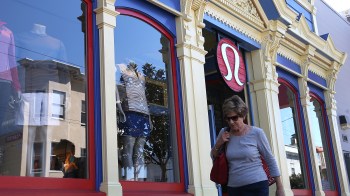
While the secondhand market booms, thrifting is coming apart at the seams
While the secondhand market booms, thrifting is coming apart at the seams

Thrift stores have long provided consumers with a source for cheaper clothing. For some, thrift shopping is driven by necessity; for others, it’s more about the thrill of the hunt and nabbing just the right blouse (or bag … or sneakers … or band T-shirt) before someone else does, often at a steal. And Generation Z (those born between 1997 to 2012) really loves the hunt.
With a hunger for individuality and sustainability, Gen Z is helping push the growth of secondhand clothing resale. Used clothing retailer ThredUp estimates that the global resale market could boom in value to $350 billion by 2027.
But the surge in the secondhand market has some drawbacks — one of the most evident being the declining quality of the clothing that makes it to thrift store racks. That change is one that Business Insider reporter Kelsey Vlamis noticed and recently wrote about. She spoke with “Marketplace” host Kai Ryssdal about how thrifting has changed. The following is an edited transcript of their conversation.
Kai Ryssdal: All right, so the basic outline of thrifting. I gave up on top. Here’s my question, though: It has changed a lot.
Kelsey Vlamis: Yeah, it has. It’s really changed a lot. I mean, [what] a lot of people — myself included, as a millennial — think of as thrifting is you go to a Goodwill or Salvation Army, basically a donation center, and you have to sort through racks to find something you like. But now there’s also many other avenues to buy used clothing, either online, in physical boutiques, on Instagram. There’s just a lot of different ways to buy secondhand.
Ryssdal: So here’s the $64,000 question: Why and how did that happen?
Vlamis: Basically, there’s just been more avenues for people to get rid of the clothes they no longer want. The growth has largely been driven by Gen Z, which is really interested in individuality and trying to find pieces that nobody else has. I mean, with the growth of sites like Depop and The RealReal and Poshmark, and the combination of Gen Z wanting new and unique things, it’s just really taken off.
Ryssdal: It’s interesting, because, you know, you mentioned The RealReal and all the rest of those. I think — and look, this is definitely a generational thing. I was about to say, “Maybe it’s a generational thing,” but it’s definitely a generational thing. There are people out there, some of them younger people actually, like my kids, they will go to Goodwill and Salvation Army, do their thrifting there as opposed to online.
Vlamis: Definitely. And when you go in person, it’s definitely more about the thrill of the hunt. You really don’t know if you’re gonna find anything. But there is some really good feeling about sifting through a ton of racks and just stumbling across something perfect. Whereas when you’re online or on these curated shops, it doesn’t have quite the same level of excitement when you just stumble across a treasure at a thrift store.
Ryssdal: Yeah, it also has turned Goodwill and Salvation Army into actual retailers too, right. I mean, they’ve got like retail centers.
Vlamis: Yeah, absolutely. And I mean, Goodwill has specific shops where they’ve curated secondhand things. And also online. I mean, you can look through tons of secondhand things people have donated, and they recognized this is something people want, we can curate this into an online shop, people will seek it out, and they’ll pay a little bit more for it.
Ryssdal: One of the things you mentioned in this piece that struck me was the the role, I guess, of fast fashion in this change in the thrift environment.
Vlamis: Definitely. I mean, fast fashion obviously is growing. And you can just go on TikTok, you can see hauls from fast fashion shops where TikTokkers are just sorting through dozens of things they bought from a fast fashion shop online, and the things are very cheap. And so if they don’t like it or it doesn’t fit, instead of going through the effort to return it, a lot of people will just donate it.
Ryssdal: What’s the price equation, right? I mean, there’s all this volume out there now. Has the price equation — that is to say, generally speaking, secondhand goods are cheaper, right — is that still the case? And if so, are people being priced out, you know?
Vlamis: Yeah, secondhand goods are still cheaper. But even those traditional donation-type thrift stores are seeing an increase in prices. And then part of that, I think, is just, you know, regular price increases and also just knowing that people will pay a little bit more because there is more popularity in thrifting. So the problem is a lot of times with secondhand shoppers, there’s need-based shoppers and then there’s trend-based shoppers. And need-based shoppers are increasingly getting priced out, and it’s getting harder to find those, like, special pieces at an affordable price.
Ryssdal: Right. Back to the thrill of the hunt thing. Are you a practitioner? Do you go out there and, you know, try to find those goodies?
Vlamis: Yeah, I am. I mean, I will say as I’ve gotten older, I definitely stick more to more curated shops. Honestly, I wrote this story because I did go to a traditional donation-center thrift store and I just couldn’t find anything on the racks that felt like, you know, really quality clothing. Which is. you know, not my experience of thrifting when I did it when I was younger. So I am a practitioner. There’s definitely still a thrill of the hunt, it still feels great, but I did notice personally it was getting a little harder to find the good stuff.
There’s a lot happening in the world. Through it all, Marketplace is here for you.
You rely on Marketplace to break down the world’s events and tell you how it affects you in a fact-based, approachable way. We rely on your financial support to keep making that possible.
Your donation today powers the independent journalism that you rely on. For just $5/month, you can help sustain Marketplace so we can keep reporting on the things that matter to you.

















